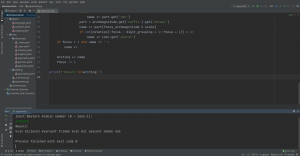Difference between revisions of "Language/Multiple-languages/Culture/Numeration-Tutorial"
| Line 48: | Line 48: | ||
== What's the future plan? == | == What's the future plan? == | ||
I need to add features mentioned in 'about/subject.yaml' for Esperanto, then add support to other 4 languages mentioned in 'about/language.yaml' and notations mentioned in 'about/notation.yaml', then I will start supporting other languages. I will add a guidance on adding a new language, then add the TTS | I need to add features mentioned in 'about/subject.yaml' for Esperanto, then add support to other 4 languages mentioned in 'about/language.yaml' and notations mentioned in 'about/notation.yaml', then I will start supporting other languages. I will add a guidance on adding a new language, then add the TTS support, create a GUI with [https://beeware.org/ BeeWare] after all of this. I need to accumulate experience through this project, then I can create other ones. | ||
Revision as of 18:55, 20 October 2020
Finally, the first version of the Numeration tool is released! This version will allow you to practise some Esperanto numerals! More languages to come...
What is the Numeration tool?
This tool will help you practise reading, writing (hopefully also listening to and speaking) numbers, written in Python and YAML.
The Numeration project is for practising conversion of numbers between symbols and writing systems.
Address: https://gitlab.com/GrimPixel/Numeration
NB: It would be ridiculous to post this tutorial on GitLab, because this tutorial's target readers are non-programmers, so it is too detailed for programmers.
What are Python and YAML and why choose them?
Python
Python is one of the most favoured languages.
Why not Rust or TypeScript, but Python? Well, because Python codes are very easy to maintain. Python also has some unique useful features including f-string and negative indexing. In addition, Python has a lot of scientific libraries, so it is more relevant to my main area of study.
YAML
YAML is one of the most useful data serialization formats.
And why not JSON or TOML, but YAML? Because YAML has high readability and is very easy to maintain, at least no need to type soo many quotation marks.
How to get started with Numeration?
1. Download the latest Python and install it, so you can run Python programs
2. Download PyCharm, an integrated development environment (IDE), and install it, so you have a graphical user interface (GUI) to edit the code or run it. Alternative: Pyzo.
3. Download Python's YAML parser, so that Python interpreter can understand YAML. If you are using Windows, tap WinKey, input "cmd", tap Enter, so the command line is opened. Copy the line starting with "pip" in that webpage, paste into the command line window, tap Enter. For users of other operating systems, you should already have known how to open the command line of your system, I suppose.
They are all open-source.
After doing this, go to that Address above. Download the source code and extract the compressed file. Keep the directory structure unchanged, otherwise you need to change the code to run the program.
Open PyCharm, open the project directory, open 'rule/esperanto.py'.
Tap "Ctrl + Shift + F10" to run the code in current tab. Tap "Shift + F10" to run the code in the file specified on the upper-right corner.
If you are still confused about PyCharm, please watch the first sections of that Mosh's tutorial above.
What's the future plan?
I need to add features mentioned in 'about/subject.yaml' for Esperanto, then add support to other 4 languages mentioned in 'about/language.yaml' and notations mentioned in 'about/notation.yaml', then I will start supporting other languages. I will add a guidance on adding a new language, then add the TTS support, create a GUI with BeeWare after all of this. I need to accumulate experience through this project, then I can create other ones.
